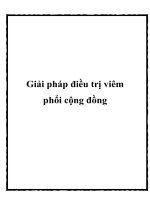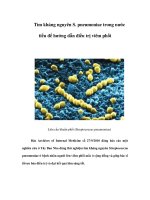phác đồ hướng dẫn điều trị viêm phổi cộng đồngtrong kỷ nguyên kháng thuốc
Bạn đang xem bản rút gọn của tài liệu. Xem và tải ngay bản đầy đủ của tài liệu tại đây (1003.29 KB, 50 trang )
PHÁC ĐỒ HƯỚNG DẪN ĐIỀU TRỊ
VIÊM PHỔI CỘNG ĐỒNG
TRONG KỶ NGUYÊN KHÁNG
THUỐC
PGS.TS .PHAN HỮU NGUYỆT DIỄM
DỊCH TỄ
• Viêm phổi nguyên nhân tử vong hàng
đầu trẻ <5 tuổi
• WHO : khoảng 9 triệu trẻ tử vong, 20% do
VP (2007)
• 98% trẻ tử vong do VP sống ở các nước
đang phát triển
Global Action Plan for Prevention and Control of Pneumonia (GAPP). Geneva:
World Health Organization (WHO)/United Nations Children’s Fund (UNICEF), 2009
Global Coalition Against Child Pneumonia. Baltimore, MD: International Vaccine Access Center (IVAC)
at Johns Hopkins Bloomberg School of Public Health, 2011.
MỤC TIÊU CỦA WHO
• Giảm tử vong do VP ở trẻ dưới 5 tuổi còn
2/3 vào 2015 ( so với 1990)
GAPP. Geneva: WHO/UNICEF, 2009.
CÂU HỎI ĐẶT RA
• Làm sao giảm tử vong trong tình hình
kháng thuốc ?
• Sự đề kháng của phế cầu với β lactam có
ảnh hưởng đến việc điều trị VPCĐ hay
không ?
• Phác đồ điều trị nào là thích hợp cho bn
ngoại trú, nội trú ?
PHÂN LOẠI VIÊM PHỔI
2 – 59 th (WHO)
PHÂN LOẠI TC LÂM SÀNG
VIÊM PHỔI Thở nhanh
VIÊM PHỔI NẶNG Co lõm ngực
VIÊM PHỔI RẤT
NẶNG
Tím tái trung ương
Co giật
Không uống được
Li bì – khó đánh thức
Suy dinh dưỡng nặng
XỬ TRÍ
CHẨN ĐOÁN XỬ TRÍ
VIÊM PHỔI NGOẠI TRÚ : KS uống
VIÊM PHỔI NẶNG Nhập viện : KS chích
VIÊM PHỔI RẤT
NẶNG
Nhập cấp cứu : KS chích;
hỗ trợ hô hấp
*Đối với trẻ < 2 tháng mọi trường hợp VP đều là VP nặng
và cần phải nhập viện
Nguyên tắc chọn kháng sinh
điều trị VPCĐ
1. Theo kinh nghiệm :
VK theo tuổi và đề kháng kháng sinh
2. Tính hiệu quả của KS
3. Độ nặng của VPCĐ
4. Cơ địa bệnh nhân
Không có MIC
KS chủ yếu nhắm vào nhóm vi trùng phổ
biến nhất theo lứa tuổi .
ĐIỀU TRỊ VPCĐ TRẺ EM
(WHO – AAP)
ĐIỀU TRỊ THEO KINH NGHIỆM
TÁC NHÂN VI SINH
SS 1-3 TH 1-12 TH
1-5 T
> 5 T
Strepto
B
ENTERIC
GR(-)
Chlamydia
trachomatis
Virus
Bordetella
pertussis
Virus
Strep.
pneumonia
H. Influenzae
Stap. aureus
Moraxella
catarrhalis
Virus
Strep.
pneumonia
H. Influenza
Staph.aureus
M.Pneumonia
C. Pneumonia
Strep.
pneumonia
M.Pneumonia
C. Pneumonia
KENDIG’S 2012
TÌNH HÌNH KHÁNG THUỐC
TẠI VIỆT NAM ?
Changing trends in antimicrobial resistance and serotypes of Streptococcus pneumoniae isolates in
Asian countries: an Asian Network for Surveillance of Resistant Pathogens (ANSORP) study.
Kim SH, Song JH, Chung DR, Thamlikitkul V, Yang Y, Wang H, Lu M, So TM, Hsueh PR, Yasin RM, Carlos CC, Pham HV, Lalitha MK, Shimono
N, Perera J, Shibl AM, Baek JY, Kang CI, Ko KS, Peck KR; ANSORP Study Group.
Collaborators (122)
ANTI MICROB AGENTS CHEMOTHER2012 Mar;56(3):1418-26. doi: 10.1128/AAC.05658-11. Epub 2012 Jan 9A
Antimicrobial resistance in Streptococcus pneumoniae remains a serious concern worldwide,
particularly in Asian countries, despite the introduction of heptavalent pneumococcal conjugate
vaccine (PCV7). The Asian Network for Surveillance of Resistant Pathogens (ANSORP) performed a
prospective surveillance study of 2,184 S. pneumoniae isolates collected from patients with
pneumococcal infections from 60 hospitals in 11 Asian countries from 2008 to 2009. Among
nonmeningeal isolates, the prevalence rate of penicillin-nonsusceptible pneumococci (MIC, ≥ 4 μg/ml)
was 4.6% and penicillin resistance (MIC, ≥ 8 μg/ml) was extremely rare (0.7%). Resistance to
erythromycin was very prevalent in the region (72.7%); the highest rates were in China (96.4%),
Taiwan (84.9%), and Vietnam (80.7%). Multidrug resistance (MDR) was observed in 59.3% of isolates
from Asian countries. Major serotypes were 19F (23.5%), 23F (10.0%), 19A (8.2%), 14 (7.3%), and 6B
(7.3%). Overall, 52.5% of isolates showed PCV7 serotypes, ranging from 16.1% in Philippines to 75.1%
in Vietnam. Serotypes 19A (8.2%), 3 (6.2%), and 6A (4.2%) were the most prominent non-PCV7
serotypes in the Asian region. Among isolates with serotype 19A, 86.0% and 79.8% showed
erythromycin resistance and MDR, respectively. The most remarkable findings about the
epidemiology of S. pneumoniae in Asian countries after the introduction of PCV7 were the high
prevalence of macrolide resistance and MDR and distinctive increases in serotype 19A.
MỘT NGHIÊN CỨU GẦN ĐÂY
.
Decreased Streptococcus pneumoniae
susceptibility to oral antibiotics among
children in rural Vietnam: a community study
Nguyen Quynh Hoa, Nguyen V Trung, Mattias Larsson, Bo
Eriksson, Ho D Phuc, Nguyen TK Chuc and Cecilia Stalsby
Lundborg
BMC Infectious Diseases 2010, 10:85 doi:10.1186/1471-2334-10-85
421 phân lập được S. pneumoniae.
95% (401/421) đề kháng tối thiểu 1 loại kháng sinh
Mức đề kháng cao :
• co-trimoxazole (khuyến cáo của WHO !)
• tetracycline
• penicillin V
• erythromycin (70-78%; đề kháng chéo với macrolides khác).
BMC Infectious Diseases 2010, 10:85 doi:10.1186/1471-2334-10-85
ĐỀ KHÁNG KHÁNG SINH
TẠI QUẬN BA VÌ, VIỆT NAM
VIỆT NAM
Conclusions: Resistance to commonly used antibiotics and multidrug-resistance of S.
pneumoniae is markedly high. High dose of amoxicillin is the only oral antibiotic that
can possibly be used when treatment is required for community-acquired
pneumococcal infections. Most of children had used antibiotics unnecessarily during
their most recent illness and in the 28-day period during the study. There is a serious
lack of knowledge on appropriate antibiotic use among the HCPs as well as the
caregivers. Antibiotics are often prescribed or dispensed for common colds.
High antibiotic use and resistance among children under five
Acute respiratory infections: knowledge and behaviour
of caregivers and health-care providers in Vietnam
Thesis for doctoral degree (Ph.D.) 2010
Nguyên Quynh Hoa
TÌNH HÌNH KHÁNG THUỐC TẠI VIỆT NAM
Drug-resistant pneumococci in children with acute
lower respiratory infections in Vietnam.
Watanabe K, Anh DD, Huong Ple T, Nguyet NT, Anh NT, Thi NT, Dung NT,
Phuong DM, Rusizoka OS, Nagatake T, Watanabe H, Oishi K.
Department of Internal Medicine, International Research Center for Infectious
Diseases, Institute of Microbial Diseases, Osaka University, Japan.
Pediatr Int. 2008 Aug;50(4):514-8.
PHƯƠNG PHÁP :
•220 trẻ < 5T bi nhiễm trùng hh dưới ( 2001 and 2002). 53
trường hợp cấy từ phết mũi họng pneumococcal (+) được cấy
định lượng và nghiên cứu về gen và serotype
KẾT QUẢ:
• 73.6% of pneumococcal là genotypic penicillin-resistant
Streptococcus pnemoniae (gPRSP), thay đổi penicillin-binding
protein genes pbp 1a + 2x + 2b: 67.9% và đồng thời có “ ermB
gene” gây kháng cao với erythromycine.Phần lớn chủng gPRSP
có serotype 19F hoặc 23F.
KẾT LUẬN:
•
Chủng VT có gPRSP với serotype 19F hay 23F chiếm tỷ lệ cao ở
trẻ em < 5 tuổi có NTHHD ở H à nội, Vietnam.
Dữ kiện gần nhất về kháng thuốc trong
NTHH tại BV Bạch Mai *
TẠI BỆNH VIỆN NĐ1
• NĂM 2011, nghiên cứu 196 bệnh nhi VPCĐN có
40,3% trẻ dưới 12 tháng tuổi,17,3% trẻ bị suy dinh
dưỡng, chủ yếu là dạng nhẹ.
•
Phân lập VT bằng phương pháp hút dịch khí quản
qua đường mũi : 30 trường hợp cấydương tính Strep.
pneumoniae là vi trùng chiếm 23,3%, còn nhạy 100%
Ceftriaxone, kháng 100% Penicilline
• Sự đề kháng của phế cầu với β lactam có
ảnh hưởng đến việc điều trị VPCĐ hay
không ?
CƠ CHẾ ĐỀ KHÁNG THUÔC
CƠ CHẾ ĐỀ KHÁNG VÀ CÁCH XỬ TRÍ
VI TRÙNG CƠ CHẾ LÀM GÌ ? THÀNH CÔNG ?
Streptococcus
pneumoniae
Thay đổi target
PBP2x gắn kết
penicillin
Tăng liều β-lactams
Môt phần
(MIC 4 mg/L)
Thay đổi target
đvoi macrolides,
lincosamides
Không (high-level
resistance )
không
Bơm thuốc ngược
lại (efflux for
macrolides)
Tăng liều ,
Dùng ketolides hay
16- membered
macrolides
Còn bàn cãi
Telithromycin hiệu
quả nhưng độc tính
Bơm thuốc ngược
lại (efflux for
fluoroquinolones )
Tránh dùng
fluoroquinolones
(ciprofloxacin,
gemifloxacin)
Có (nếu dùng
moxifloxacin)
CƠ CHẾ ĐỀ KHÁNG VÀ CÁCH XỬ TRÍ
VI TRÙNG CƠ CHẾ LÀM GÌ ? THÀNH CÔNG ?
Haemophilus
influenzae
β-lactamase
Thêm ức chế β-
lactamase
Có
Thay đổi Target
for β- lactams
Đề kháng cao
(high level
resistance )
không
Moraxella
catarrhalis
β-lactamase
Thêm ức chế β-
lactamase Có
Staphylococcus
aureus
methicillin-
resistance
dùng vancomycin,
linezolid, or
daptomycin
Có nhưng hạn
chế (vancomycin;
daptomycin) và
độc toxicities
Mycoplasma
pneumoniae
Thay đổiTarget for
macrolides
Không (high level
resistance)
không
Pneumococcal Penicillin Resistance
• MIC < 0.06 µg/mL: very susceptible
– Amoxicillin uống liềuthông thường có hiệu quả
• MIC 0.12-1 µg/mL: susceptible
– Amoxicillin uống liều cao có hiệu quả
•
MIC 1-2: somewhat resistant
– Amoxicillin uống liều cao có hiệu quả >90%
• MIC 2-4: resistant
– Uống không hiệu quả; IV ampicillin hay penicillin
• MIC >4: very resistant
– Ampi hay penicilline không hiệu quả; ceftriaxone
hiệu quả
Clin Infect Dis 2011; 53 (7): 617-630
• Phác đồ điều trị nào là thích hợp cho bn
ngoại trú, nội trú ?









